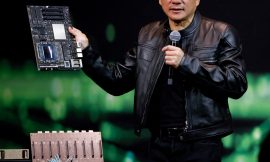Government leaders have welcomed clarity on the EU-US trade deal, which sets a maximum tariff rate of 15% for the pharmaceutical sector.
Taoiseach Micheál Martin said it was a “significant win” for the European Union and highlighted the arrangements for the pharmaceutical and aviation sectors.
The EU-US framework trade agreement, published today, said that as of 1 September, the US will apply a maximum tariff rate of 15% on “generic pharmaceuticals and their ingredients and chemical precursors”.
Mr Martin said the statement brought “greater clarity and certainty” to what the deal will mean in practice.
“This is especially important for enterprises that either import from or export to the US.
“Given the scale of the pharmaceutical and semiconductor sectors in Ireland, it is important that the Joint Statement confirms that 15% is a ceiling that will apply to EU exports in these areas in all circumstances, including when the current US Section 232 investigations are concluded.
“While I have been clear all along that I do not support tariffs, this is a significant win for the EU.
“Given the significance of the airline sector to Ireland, a specific carve-out for aircraft and aircraft parts is also welcome.
“There are areas where further work remains to be done, including a potential carve-out for med-tech products and spirits.
“I hope this will be advanced as quickly as possible. We will continue to advocate for these sectors given their significant importance to our domestic economy,” Mr Martin said.
Tánaiste Simon Harris, who is Minister for Foreign Affairs and Trade, welcomed the clarity the statement offered on the agreement announced on 27 July.
EU-US trade agreement ‘brings clarity’ to EU businesses, says Tánaiste
“We welcome clarity that the deal includes a single, all-inclusive 15% tariff on EU goods.
“We also now have assurance that this rate will extend to pharmaceuticals and semiconductors.
“This provides an important shield to Irish exporters that could have been subject to much larger tariffs pending the outcomes of Section 232 US investigations into these sectors,” Mr Harris said.
There is also a “zero-for-zero” tariff rate for aircraft and aircraft parts, with further carve outs to be determined for certain products in generic pharmaceuticals and chemicals.
Mr Harris said this offered a “first step” to a more “comprehensive and formal agreement with the US in the future”.
“Our intention now is to see what other carve outs can be made in areas of interest for Irish exporters.”
Earlier, in a statement, the Tánaiste said that Ireland “must continue to control what we can control and continue to make our country, and our European Union, as competitive as possible, as good a location as possible to invest in and create jobs.
“We must also look for other opportunities to diversify markets for Irish business. While we want to continue to do business with the US and indeed want to grow business. It is important that we take every opportunity to identify new markets.
“On Monday, we will publish Ireland’s new Market Diversification Action Plan,” Mr Harris added.
Read more:
What’s in Trump’s trade deal with Europe?
The US and the European Union said they had locked in a framework trade deal that includes a 15% US tariff on most EU imports, including cars, pharmaceuticals, semiconductors and lumber.
In a three and a half page joint statement, the two sides listed the commitments made, including the EU’s pledge to eliminate tariffs on all US industrial goods and to provide preferential market access for a wide range of US seafood and agricultural goods.
Washington will take steps to reduce the current 27.5% US tariffs on cars and car parts, a huge burden for European makers, once Brussels introduces the legislation needed to enact promised tariff cuts on US goods, it said.
US President Donald Trump and European Commission President Ursula von der Leyen announced the deal on 27 July at Mr Trump’s luxury golf course in Scotland after an hour-long meeting that followed months of negotiations.
The two leaders met again this week as part of negotiations aimed at ending Russia’s war in Ukraine, with both lauding their trade framework deal as an historic accomplishment. The joint statement said the deal could be expanded over time to cover additional areas and further improve market access.

A senior administration official, speaking on condition of anonymity because they were not authorised to speak publicly, said European carmakers could see relief from the current US tariffs within “hopefully weeks.”
“As soon as they’re able to introduce that legislation – and I don’t mean pass it and fully implement it, but really introduce it – then we will be in a position to provide that relief. And I will say that both sides are very interested in moving quickly,” they said.
The joint statement was “a play to hold each other accountable” and ensure that both sides carried out the pledges announced last month, the official said.
“We are trying to sequence with the European Union to make sure that they feel sufficient pressure to obtain the mandate they need to begin the legislative process for reducing their tariffs, as they’ve promised,” the official said.
“We’re confident that they’ll do that. It’s just good for all parties to make sure that everyone’s on the same page and taking actions around the same time.”
The statement said US tariff relief on autos and auto parts would kick in on the first day of the month in which the EU introduced the legislation, offering the prospect of retroactive relief for carmakers. It was not immediately clear when Brussels would start the legislative process.
It noted that the US agreed to apply only Most Favored Nation tariffs from September 1 on EU aircraft and parts, generic pharmaceuticals and ingredients, chemical precursors and unavailable natural resources, including cork.
It reiterated the EU’s intention to procure $750 billion in US liquefied natural gas (LNG), oil and nuclear energy products, plus an additional $40 billion of US-made artificial intelligence chips.
It also repeated the intention for EU companies to invest an additional $600 billion across US strategic sectors up to 2028.
Both sides committed to address “unjustified digital trade barriers,” the statement said, and the EU agreed not to adopt network usage fees.
They also agreed to negotiate rules of origin to ensure that the agreement’s benefits accrued predominantly to both trading partners.
In addition, they said they would consider cooperation to ring-fence their respective steel and aluminum markets from overcapacity, while ensuring secure supply chains between each other, including through tariff quotas.
Agreement stabilises transatlantic trade – EU
European Commission Spokesperson on Trade Olof Gill said the agreement stabilises trade between the EU and US.
“Essentially, what this joint statement between the EU and US delivers is everything the European Union promised when the two presidents, Trump and von der Leyen, met in Scotland a few weeks ago,” he said.
Speaking on RTÉ’s Drivetime, Mr Gill said the 15% tariff is “across the board” for all EU exports to the US.
He said it was “guaranteed” and a “commitment” that pharmaceuticals would be taxed at 15%.
“We pushed for this, the Americans gave us a commitment and now that has been reflected in the joint statement,” Mr Gill said.
He said the 15% tariff gives pharmaceutical exporters the “security and stability” they need to keep selling into the US market.
Ibec’s Executive Director of Lobbying and Influence, Fergal O’Brien, said the joint statement provides further clarity on the new trading reality, adding that its a reality that presents considerable competitiveness challenges for many Irish and European businesses.
“While we now have greater confirmation on the sectors subject to a maximum 15% tariff, additional details are still needed on some products, particularly where the US has committed to apply only the MFN tariff, such as generic pharmaceuticals, their ingredients, and chemical precursors,” said Mr O’Brien.
“We also remain acutely aware that a number of sectors operating on smaller margins, and those heavily reliant on the US, continue to face significant pressure. These sectors will require ongoing support to navigate this new trading relationship between the EU and US and we will work with Government and the EU to continue to push for further zero for zero product agreements with US negotiators,” he added.
Mr O’Brien cautioned that focus must remain on strengthening the fundamentals that enhance Ireland’s business offering, such as workforce development, infrastructure, innovation performance and cost competitiveness, if they are to navigate the challenges ahead.

Drinks Ireland and the Irish Whiskey Association, representing manufacturers and exporters, expressed disappointment that the statement failed to return spirits and alcohol products to zero-for-zero tariff level.
The groups described it as a “missed opportunity to help businesses facing unprecedented and exceptional pressure”.
Director of Drinks Ireland Cormac Healy said: “The EU and US agreed to this zero-for-zero arrangement in 1997, and this greatly benefitted our shared sector on both sides of the Atlantic. It is therefore logical to return to this as quickly as possible.”
“As it currently stands, Irish Whiskey and drinks producers face a 15% tariff when exporting to the USA – our biggest market.
“This, combined with a weakened dollar, has placed significant pressure on our distillers, and some have unfortunately had to close their doors.
“A return to zero-to-zero would alleviate pressure on these companies, which account for annual exports valued at €2.1 billion,” he said.
Mr Healy said EU negotiators must remain at the negotiating table to secure a swift return to the zero-for-zero trading position, and called on the Government to deliver targeted sector supports for under-pressure businesses to help sustain them.
The Irish Farmers’ Association welcomed the clarity brought by the agreement, but said that overall the tariffs will have a negative impact.
IFA President Francie Gorman said: “While we might have more certainty, there is no question that a 15% tariff will have significant implications for our exports.
“It is also still unclear what level of tariff will be imposed on other products such as Irish whiskey and liqueurs. This uncertainty comes at a very difficult time for our tillage sector, with global trends going in the wrong direction.”
“From an Irish and European farmer perspective, the cost of any additional tariffs will ultimately be borne by the primary producer,” he added.




